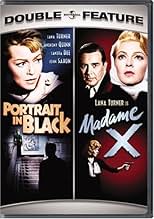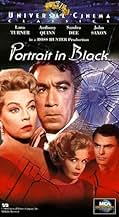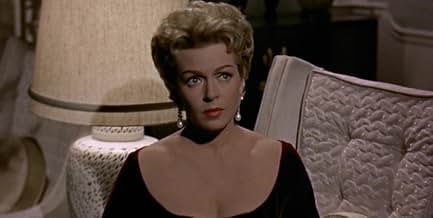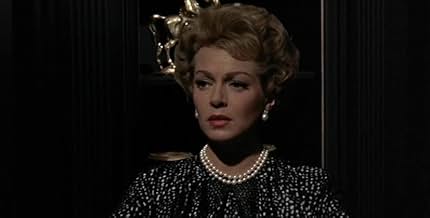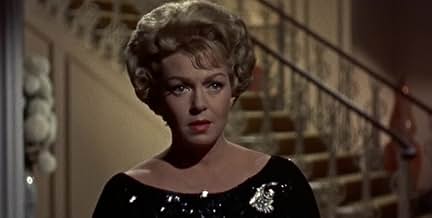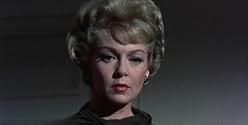ÉVALUATION IMDb
6,4/10
1,9 k
MA NOTE
Après qu'une femme mariée et son amant assassinent son cruel mari, ils se retrouvent pris pour cible par une personne au courant de leur crime.Après qu'une femme mariée et son amant assassinent son cruel mari, ils se retrouvent pris pour cible par une personne au courant de leur crime.Après qu'une femme mariée et son amant assassinent son cruel mari, ils se retrouvent pris pour cible par une personne au courant de leur crime.
Avis en vedette
Portrait In Black is in many respects typical of the Ross Hunter films that rejuvenated Lana Turner's later career. If you're a fan of the genre, this one is quite entertaining, and in my opinion far superior to the previous year's terrible remake of Imitation of Life.
Portrait In Black brings us a torrid soap opera revolving around the relationship between the wife of a wealthy shipping magnate, Sheila Cabot, and her husband's physician, Dr. David Rivera. Unable to bear having only a few stolen moments for the each other, they conspire to murder Sheila's husband so they can be together. They subsequently find themselves blackmailed and must determine who is the blackmailer and how they will extricate themselves from this web of danger that continues to keep them separated.
As previous reviewers have pointed out, there are some rather silly aspects to the story, but these again are typical of the genre. For beginners, Sheila's husband Matt Cabot is said to have a hopeless terminal illness and to have been ill for many months. Thus, their motivation for murdering him is rather weak; he will soon die without any malicious intent on their part. If they really could not bear the wait, the idea proposed in the script, that they cannot just run away together because Matt Cabot would ruin Dr. Rivera's career and he would "never practice medicine again", is a rather unrealistic threat (although admittedly common in soap opera land). Dr. Rivera's home gives the impression he is already quite wealthy, it is not as though these two would be condemned to a life of poverty and want. These plot holes are exasperated by the poorly directed love scenes between David and Sheila, which consist of much-overplayed melodramatic panting, gasping, crying, and an inordinate and unnatural amount of chewing on one another's hands. Secondly, there are a few script blunders that could have been easily corrected. When Dr. Rivera requires Sheila to drive, he puts her in the car and has to explain what the gas and brake are for, yet in scene one we are told Sheila has been issued a learner's permit by the Department of Motor Vehicles. A learner's permit allows one to drive so long as another licensed driver is present, and one would obviously have to have mastered the basics of what makes the car go in order to be issued such a permit. The plot of device that Sheila "doesn't drive" would have been far more believable without the unnecessary learner's permit in the script. There are a number of similar absent-minded script errors here.
Having said that, one does not watch a period Ross Hunter soaper for realism. One watches it for drama, and the lush and beautiful feel we expect from Mr. Hunter. In this regard, Portrait does not disappoint. Our setting is upper crust Nob Hill in San Francisco. The Cabot home, with the exception of the library being inexplicably painted black, is breathtaking. Lana Turner is stunning, and of course immaculately outfitted in high class fashions, shoes, hats, furs, and jewels at all times, as is Sandra Dee in her second role as Lana Turner's daughter (well, step-daughter in this one). Drama abounds and the at times weak script is handled expertly by the well seasoned cast, including Richard Basehart, Ray Walston, Virginia Grey, Anna Mae Wong, and John Saxon. While Anthony Quinn would have been ideally suited to his role of Dr. David Rivera if the film had been made fifteen years earlier, he is so badly addled by Michael Gordon's incompetent direction in this role it makes him seem a bit past it (with the exception of Pillow Talk, none of Mr. Gordon's films are particularly well directed).
All things considered, this film easily meets its purpose, to entertain and is fun to watch if you can find it. It is not out on DVD, is no longer available on VHS, and is seldom aired on television. But if you get the chance, it's well worth a watch.
UPDATE: This film was release on DVD in Jan 2008, and it looks great!
Portrait In Black brings us a torrid soap opera revolving around the relationship between the wife of a wealthy shipping magnate, Sheila Cabot, and her husband's physician, Dr. David Rivera. Unable to bear having only a few stolen moments for the each other, they conspire to murder Sheila's husband so they can be together. They subsequently find themselves blackmailed and must determine who is the blackmailer and how they will extricate themselves from this web of danger that continues to keep them separated.
As previous reviewers have pointed out, there are some rather silly aspects to the story, but these again are typical of the genre. For beginners, Sheila's husband Matt Cabot is said to have a hopeless terminal illness and to have been ill for many months. Thus, their motivation for murdering him is rather weak; he will soon die without any malicious intent on their part. If they really could not bear the wait, the idea proposed in the script, that they cannot just run away together because Matt Cabot would ruin Dr. Rivera's career and he would "never practice medicine again", is a rather unrealistic threat (although admittedly common in soap opera land). Dr. Rivera's home gives the impression he is already quite wealthy, it is not as though these two would be condemned to a life of poverty and want. These plot holes are exasperated by the poorly directed love scenes between David and Sheila, which consist of much-overplayed melodramatic panting, gasping, crying, and an inordinate and unnatural amount of chewing on one another's hands. Secondly, there are a few script blunders that could have been easily corrected. When Dr. Rivera requires Sheila to drive, he puts her in the car and has to explain what the gas and brake are for, yet in scene one we are told Sheila has been issued a learner's permit by the Department of Motor Vehicles. A learner's permit allows one to drive so long as another licensed driver is present, and one would obviously have to have mastered the basics of what makes the car go in order to be issued such a permit. The plot of device that Sheila "doesn't drive" would have been far more believable without the unnecessary learner's permit in the script. There are a number of similar absent-minded script errors here.
Having said that, one does not watch a period Ross Hunter soaper for realism. One watches it for drama, and the lush and beautiful feel we expect from Mr. Hunter. In this regard, Portrait does not disappoint. Our setting is upper crust Nob Hill in San Francisco. The Cabot home, with the exception of the library being inexplicably painted black, is breathtaking. Lana Turner is stunning, and of course immaculately outfitted in high class fashions, shoes, hats, furs, and jewels at all times, as is Sandra Dee in her second role as Lana Turner's daughter (well, step-daughter in this one). Drama abounds and the at times weak script is handled expertly by the well seasoned cast, including Richard Basehart, Ray Walston, Virginia Grey, Anna Mae Wong, and John Saxon. While Anthony Quinn would have been ideally suited to his role of Dr. David Rivera if the film had been made fifteen years earlier, he is so badly addled by Michael Gordon's incompetent direction in this role it makes him seem a bit past it (with the exception of Pillow Talk, none of Mr. Gordon's films are particularly well directed).
All things considered, this film easily meets its purpose, to entertain and is fun to watch if you can find it. It is not out on DVD, is no longer available on VHS, and is seldom aired on television. But if you get the chance, it's well worth a watch.
UPDATE: This film was release on DVD in Jan 2008, and it looks great!
"Portrait in Black" is another of Ross Hunter's late '50s-early '60s productions for Universal-International. Like his others, this is a beautifully realized film with an excellent budget and meticulous attention paid to every detail, ensuring the cast looked their best and the story was brought about with taste and credibility.
I've always liked this glossy, good-looking movie. However I must say I personally don't think Anthony Quinn was right for the role of the doctor. Gregory Peck, with his noble features and polished manner, would have brought an interesting dimension to that part.
Beautiful sets, hair styles, clothes, cars, manners and language. A delight to behold. Enjoy.
I've always liked this glossy, good-looking movie. However I must say I personally don't think Anthony Quinn was right for the role of the doctor. Gregory Peck, with his noble features and polished manner, would have brought an interesting dimension to that part.
Beautiful sets, hair styles, clothes, cars, manners and language. A delight to behold. Enjoy.
Portrait in Black (1960)
In a beautifully drippy, bleeding, sticky Douglas Sirk mode, and one year after leading lady Lana Turner appeared in Sirk's "Imitation of Life," this highly slick and artificial (and yet moving) melodrama is one of the high points in a low period of Hollywood. The other main character is Anthony Quinn, who is remarkable, too, one of those underrated leading men, I'm not sure why. The two of them are supported by Richard Basehart as a fascinating and chilling underling with a peculiar mysterious cheerfulness, and Sandra Dee, who plays the spoiled daughter all too well (as you can imagine).
Unlike Sirk's dramas, this one, directed by is not just about normal human dramas (soap opera stuff), but adds a criminal and suspense element that kicks in after half an hour. The throbbing music takes on a different meaning here, and the sobbing and regrets make for an intense ride.
The deeper you get into this movie, the deeper the plot gets, with intrigue and worry and more murder mounting. And it's all filmed with fluid, rich, widescreen color photography, with intensely rendered music (that holds nothing back), and with a subtle kind of attention to nuance that oddly adds to the excesses of the plot.
And it's the plot, the story, that is so finely tuned it sustains all this cinematic swaying. It's not like some movies where the music or the photography drives the plot--here they are woven together really well, artfully and emphatically. Quinn and Turner are both extraordinary, lifting what could have been a soap opera to something completely fuller.
Russell Metty, behind the camera, was at the peak of his career, having shot not only "Imitation of Life" the year before but Sirk's early "Written on the Wind" (and moving on quickly to several masterpieces like "Spartacus" and "The Misfits"). And in fact the composer, veteran Frank Skinner, wrote the music for those two classic Sirk films, as well. It's worth stressing all this because Sirk has a huge (and deserved) following, and I have a feeling this one is just under the radar of Sirk fans. If a great Sirk film seems to almost reference itself the way it becomes so perfectly "arch" in its stereotypes, "Portrait in Black" does maintain a sense of being still a film wanting to move a plot idea along (these are subtle differences about style becoming affectation on purpose). But even so, the parallels are extraordinary, and this is a remarkable movie on those terms.
It's worth wondering what else, beyond Sirk, was going on around this time, and in fact, with the murder and suspense here it helps to look at Hitchcock's films "North by Northwest" (1959) and "Vertigo" (1958). Both are clearly influences in filming style, lacking only that higher level of stylized artfulness (and storytelling) that Hitch was by then such a master of. Or then, you might say, there was perhaps the influence of Sirk on Hitchcock, at least in the visual richness and fluidity (something Hitch abandoned immediately, almost making a point, this very year with "Psycho").
Anyway, if you don't mind an over the top melodrama done to perfection, here you go. And for movie fans, check out Anna May Wong's last film appearance (not a great performance, but she's her own legend). See it on the biggest screen you can, too--this doesn't translate well at all to a laptop experience.
In a beautifully drippy, bleeding, sticky Douglas Sirk mode, and one year after leading lady Lana Turner appeared in Sirk's "Imitation of Life," this highly slick and artificial (and yet moving) melodrama is one of the high points in a low period of Hollywood. The other main character is Anthony Quinn, who is remarkable, too, one of those underrated leading men, I'm not sure why. The two of them are supported by Richard Basehart as a fascinating and chilling underling with a peculiar mysterious cheerfulness, and Sandra Dee, who plays the spoiled daughter all too well (as you can imagine).
Unlike Sirk's dramas, this one, directed by is not just about normal human dramas (soap opera stuff), but adds a criminal and suspense element that kicks in after half an hour. The throbbing music takes on a different meaning here, and the sobbing and regrets make for an intense ride.
The deeper you get into this movie, the deeper the plot gets, with intrigue and worry and more murder mounting. And it's all filmed with fluid, rich, widescreen color photography, with intensely rendered music (that holds nothing back), and with a subtle kind of attention to nuance that oddly adds to the excesses of the plot.
And it's the plot, the story, that is so finely tuned it sustains all this cinematic swaying. It's not like some movies where the music or the photography drives the plot--here they are woven together really well, artfully and emphatically. Quinn and Turner are both extraordinary, lifting what could have been a soap opera to something completely fuller.
Russell Metty, behind the camera, was at the peak of his career, having shot not only "Imitation of Life" the year before but Sirk's early "Written on the Wind" (and moving on quickly to several masterpieces like "Spartacus" and "The Misfits"). And in fact the composer, veteran Frank Skinner, wrote the music for those two classic Sirk films, as well. It's worth stressing all this because Sirk has a huge (and deserved) following, and I have a feeling this one is just under the radar of Sirk fans. If a great Sirk film seems to almost reference itself the way it becomes so perfectly "arch" in its stereotypes, "Portrait in Black" does maintain a sense of being still a film wanting to move a plot idea along (these are subtle differences about style becoming affectation on purpose). But even so, the parallels are extraordinary, and this is a remarkable movie on those terms.
It's worth wondering what else, beyond Sirk, was going on around this time, and in fact, with the murder and suspense here it helps to look at Hitchcock's films "North by Northwest" (1959) and "Vertigo" (1958). Both are clearly influences in filming style, lacking only that higher level of stylized artfulness (and storytelling) that Hitch was by then such a master of. Or then, you might say, there was perhaps the influence of Sirk on Hitchcock, at least in the visual richness and fluidity (something Hitch abandoned immediately, almost making a point, this very year with "Psycho").
Anyway, if you don't mind an over the top melodrama done to perfection, here you go. And for movie fans, check out Anna May Wong's last film appearance (not a great performance, but she's her own legend). See it on the biggest screen you can, too--this doesn't translate well at all to a laptop experience.
Oh the heartache and troubles rich people suffer through. Take Sheila Cabot (Lana Turner) for example, an attractive, middle-aged woman married to a wealthy, but ailing, shipping tycoon, Matthew Cabot (Lloyd Nolan). They live in a San Francisco mansion overlooking the Bay, and have multiple servants. But Matthew is gruff, verbally abuses his wife, and generally treats everyone like dirt. It's enough to make Sheila ... well ... cry. Making matters infinitely worse, Sheila has a lover on the side. And she's desperate to exchange the gruff hubby for the lover. However will she manage?
That's the setup for this melodrama-mystery combo, a story that involves passion, suspicion, deception, and ultimately murder. The film's easy to follow plot gets a needed boost when a card addressed to Sheila arrives in the mail. All the card says is: "Congratulations on the success of ..." That scene sends the plot hurling into mystery territory. Who wrote the card, and why?
The script's two main characters behave in ways that do not seem credible, given their circumstances. And the idea that a grown woman living in California has never learned to drive is a tad dubious.
The film's overall look and feel is that of a typical 1950s melodrama. Elegant, expensive clothes, dreamy violin background music, and melodramatic acting conjure up visions of some sudsy 1950s film directed by Douglas Sirk. I don't recall any scene in which Lana Turner is not wearing an expensive dress and, in some scenes, a full-length mink coat.
Color cinematography is acceptable, if unremarkable. Casting favors well-known actors. And they perform well enough. I was pleasantly surprised by the performance of Sandra Dee.
If you're looking for a believable story, look elsewhere. If you're looking for a sudsy melodrama and/or mystery, "Portrait In Black" will appeal. I could have done without the pretentious suds of these very rich people. But the plot puzzle provided enough mystery to keep me hooked.
That's the setup for this melodrama-mystery combo, a story that involves passion, suspicion, deception, and ultimately murder. The film's easy to follow plot gets a needed boost when a card addressed to Sheila arrives in the mail. All the card says is: "Congratulations on the success of ..." That scene sends the plot hurling into mystery territory. Who wrote the card, and why?
The script's two main characters behave in ways that do not seem credible, given their circumstances. And the idea that a grown woman living in California has never learned to drive is a tad dubious.
The film's overall look and feel is that of a typical 1950s melodrama. Elegant, expensive clothes, dreamy violin background music, and melodramatic acting conjure up visions of some sudsy 1950s film directed by Douglas Sirk. I don't recall any scene in which Lana Turner is not wearing an expensive dress and, in some scenes, a full-length mink coat.
Color cinematography is acceptable, if unremarkable. Casting favors well-known actors. And they perform well enough. I was pleasantly surprised by the performance of Sandra Dee.
If you're looking for a believable story, look elsewhere. If you're looking for a sudsy melodrama and/or mystery, "Portrait In Black" will appeal. I could have done without the pretentious suds of these very rich people. But the plot puzzle provided enough mystery to keep me hooked.
Poor Lana Turner is forced to wear Jean Louis gown after Jean Louis gown in this picture, a veritable sea of sequins. To add insult to injury, she is kept like a bird in a gilded cage in her magnificent Pacific Heights mansion. Her lover (Anthony Quinn) lives only a couple of blocks away, but in order to tryst with him, she must first go down to Union Square and pretend to shop at the old I. Magnin store (now Macy's), then take a cab back out to Divisadero - very inconvenient. An uncommonly silly movie, but great set decoration and use of locations. If you ever come to visit San Francisco, you can see the house that Lana, Sandra and Lloyd lived in; it's at the corner of Broadway and Baker, just about the ritziest neighborhood in town, natch....enjoy!
Le saviez-vous
- AnecdotesLana Turner wears jewelry in this film reportedly worth over $1.1M at the time (nearly $11M in 2022).
- GaffesWhen Miss Lee approaches Cathy and Blake in the restaurant, Blake is holding a cup in his right hand and places it down. In the next shot, he's holding the cup in his left hand and puts it down again.
- Citations
Sheila Cabot: Oh don't leave me David, please don't go away!
Dr. David Rivera: I've got to go!
Sheila Cabot: But why Darling, why? I don't know what I'll do if you go!
Dr. David Rivera: I'm - I'm afraid of what I'll do if I stay!
- ConnexionsEdited into The Green Fog (2017)
Meilleurs choix
Connectez-vous pour évaluer et surveiller les recommandations personnalisées
- How long is Portrait in Black?Propulsé par Alexa
- World Premiere Happened When & Where?
Détails
- Date de sortie
- Pays d’origine
- Langue
- Aussi connu sous le nom de
- Portrait in Black
- Lieux de tournage
- San Francisco, Californie, États-Unis(sequence at Devil's Slide on the Pacific Coast Highway - State Route 1)
- société de production
- Consultez plus de crédits d'entreprise sur IMDbPro
Box-office
- Budget
- 1 400 000 $ US (estimation)
- Durée1 heure 52 minutes
Contribuer à cette page
Suggérer une modification ou ajouter du contenu manquant

Lacune principale
By what name was Meurtre sans faire-part (1960) officially released in India in English?
Répondre


